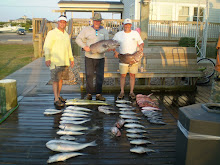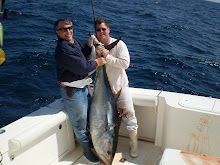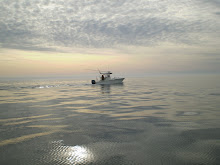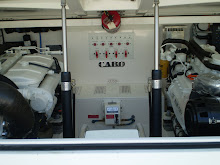
By Jim Field
I am still way too ignorant about the fish types in the Atlantic Ocean--without talking about fish species across the globe. This is sheer laziness. You would think that having caught a fish, one would take time to read about it--get to know it--for a variety of reasons. First, to know how to definitively identify it next time round. Second, to learn what its presence may mean about the immediate ocean environment you're in, e.g., what other fish may or may not "hang" with it, and the conditions that attract it. Finally, to simply honor the fish and appreciate it for what it is--honor it by acknowledging it and its inherent beauty and role in the ecosystem. But alas, I don't do this, and therefore am, by inference, an indifferent fisherman, which I don't want to be: I want to be knowledgeable! So from here forward I pledge to write posts about what we have and will catch in the future. I will be curious. I will learn. I will investigate. Promise.
Which takes us to today's post. I was refining this blog's "Fish Caught/Released on the Sea Ya Bea" list (see right-hand column all the way down), and I didn't know where to place the false albacore. So I looked it up. Here's what I dug up.
From Wikipedia
The Little Tunny is the most common tuna in the Atlantic. It is found in warm temperate and tropical waters of the Atlantic and the Mediterranean. Occurring in large schools, and weighing up to 35 pounds, it is the smallest member of the tuna Scombridae family. Commonly called "false albacore" or "albie", it resembles the Atlantic bonito, skipjack tuna and species of mackerel. It is best identified by the dark spots appearing between its pectoral and ventral fins and "worm-like" markings on its back. Originally thought of as a trash fish because its food value is so poor it is considered inedible, it is now sought after as a sport fish due to its line stripping 40 mph runs when hooked. Commercially, the fish is used as bait for sharks and marlin.
From www.flyfishinsalt.com
Fish Facts: False Albacore
For whatever reason, false albacore are among the most misidentified fish in the ocean. Also commonly called little tunny, they are frequently mistaken for bonito, albacore, tinker mackerel or other small tunas. No matter what you call them, the stamina these fish display can prove downright brutal. It has been said that it's not the size of the dog in the fight that counts, it's the size of the fight in the dog. Nothing could better describe the albie.
False albacore have risen from the ignoble status of trash fish to that of prized game fish within a few short years, and now draw anglers from around the world to test their tackle. One thing is for sure: The increase in notoriety has nothing to do with the albie's popularity as a food fish - they are far from palatable, by most accounts. The draw comes from the fight, and perhaps the fun of targeting them primarily by sight fishing.
"If albies are around and feeding, you know it," says Capt. Paul Dixon, a guide who splits his time between Montauk and Harker's Island, North Carolina. "Just watch for birds, or you'll see and hear them shredding bait on the surface," he says. Ideal fishing conditions usually include water temperatures in the 60s and plenty of bait with moving water. Albacore enthusiast Tom Earnhardt suggests letting the fish come to you once you find them. "The fish move pretty fast, and you can put them down if you 'run and gun' it. Ease around a school at idle and try not to vary the pitch of the motor too much," he suggests.
Earnhardt and Dixon agree that the fly should be cast into the bait and kept there as long as possible to increase the odds of hooking up. "There is no need for long casts and a fast two-hand retrieve if the fish are crashing on bait," says Earnhardt. "Those types of retrieves work best when you know the fish are there, but they are staying down or only coming up occasionally." They also agree that tides can prove important for false albacore. Although the fish don't seem as fussy about moving water as striped bass can be, most anglers prefer to find some kind of current, whether the tide is falling or rising.
When the fish don't show themselves, anglers resort to chumming or following behind the shrimp trawlers. "In the Keys, that's standard procedure for finding them," says Jeffrey Cardenas, a well-known Key West guide and fly shop owner. "On the Atlantic side they tend to be the redheaded stepchild while we fish for blackfin tuna. On either side, though, we have to chum them up or fish behind the shrimpers to find them. In fact it's rare that we come across a surface school like they do up north."
Albies tend to be fairly seasonal because they are migratory, following the bait and the temperature of the water. But Earnhardt believes that North Carolina has a resident population of larger albies that spends most of the cooler months in the warm waters of the Gulf Stream and then comes inshore when the bait arrives. "I refer to the smaller 8- to 10-pounders as 'Yankee fish' - the ones that come down from up north," he says. This theory would explain why North Carolina fish tend to be caught year round and are among the largest to be found.
The albie season usually begins with the first real cold front of the season. In New England, that can come in September, while in North Carolina October is the more likely month. In the Keys it might not occur until November.
In North Carolina, the best fishing occurs in October and November, usually peaking about the first week of November. Although all inlets along the Outer Banks have good false albacore populations, Earnhardt recommends Beaufort for consistently finding fish. All the inlets concentrate baitfish coming out of North Carolina's sounds - Pamlico, Albemarle and Core - much like funnels. When the tides start changing and the rips build, the bait begins to congregate and the albies show up.
Most hard-core albie fishermen prefer to use small flies. "I think the ideal size is a fly tied on a No. 2 hook, but sometimes, especially early in the season, I'll tie flies as small as No. 8s or even No. 10s," says Earnhardt. "Generally the flies are small, an inch to an inch and a half long, and tied very sparse." He recommends flies tied with tan or rust-colored materials with some flash, especially when the bay anchovies show up off North Carolina. If he were limited to three fly styles, Earnhardt would recommend Surf Candy, Clousers and Coneheads, but he is quick to add the Crease Fly, especially when fishing behind shrimpers. Both Earnhardt and Dixon suggest that the most important thing is to match the hatch in size and color. If fishing in a chum slick or behind a shrimp trawl, pattern and size don't matter as much. "It seems like they'll hit anything under those conditions," says Cardenas.
For gear, Dixon and Earnhardt strongly recommend intermediate lines, which allow the angler to come tight to the fly more quickly than with sinking lines and give him more control casting than floating ones. Reels with good drags are crucial and a 9-weight is minimal, especially later in the season. Albies tend not to be too line shy, so long leaders are not usually necessary. Earnhardt recommends 9-footers with between 12- and 16-pound tippets.
Lastly, both New England and North Carolina offer excellent opportunities to wade-fish for albies. "Just look for the drop-offs and the bait. Places like Buoy #4 at Cape Lookout are great for wading," says Earnhardt. In addition, several local shops offer ferry service for wade anglers for a small fee.
A nice artist representation. Best identified by black "squigley" lines on back that have rainbow-like hue










No comments:
Post a Comment